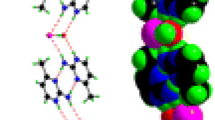Abstract
Sodium salicylate (NaSal where Sal=2-hydroxybenzoate), when mixed with dibenzo-24-crown-8 (DB24C8) yields a bimetallic complex [NaSal]2DB24C8 in most polar organic media, while potassium salicylate (KSal) under similar conditions shows a tendency to yield 1∶1 or 2∶1 complexes depending upon medium or synthesis. However, the presence of both NaSal and KSal together results in a unique mixed cation complex of composition NaKSal2DB24C8. This product melts sharply (190-92°C) without decomposition, displays IR spectral characteristics comparable to those of [Na(Sal)]2DB24C8, and is stable in aqueous media as shown by the detectable cation effect on the UV absorption bands of Sal and DB24C8. Single crystal X-ray analysis of NaK(Sal)2DB24C8 reveals that the system represents a co-crystallization complex of individual (KSal)2DB24C8 and (NaSal)2DB24C8 molecules. The crystals are monoclinic,P21/c,a=19.976(2) Å,b=9.031(1) Å,c=25.541(5) Å,β=122.065(9)°, Å3,T=298 K,Z=2+2, CuKα λ=1.5418 Å, and 2θ (2.5°–100°). FinalR factor for the 3012 observed reflections (F>3σ) is 0.092. Both the Na2- and K2-molecules possess crystallographic centers of symmetry with one metal and its associated anion on each side of the crown ring. However, the conformations of the crowns are very different in the two molecules, with the K2-crown being nearly planar and the Na2-crown being quite puckered. Four oxygen atoms from the DB24C8 (K⋯O, 2.680–2.908 Å) and three carboxyl oxygen atoms (K⋯O, 2.472–2.708 Å) from separate salicylate ions coordinate with each potassium. Three oxygens from the crown (Na⋯O, 2.536–2.65 Å) and three carboxyl oxygens (Na⋯O, 2.31–2.563 Å) coordinate with each sodium. The salicylate ions lie on opposite sides and nearly perpendicular (77.2°, Na2-molecule; 82.7° K2-molecule) to each crown but coordinate to both of the metal ions within a molecule. The K+⋯K+ and Na+⋯Na+ distances in the respective molecules are 3.95 and 3.34 Å.
Similar content being viewed by others
References
J. F. Sutcliffe: inMineral Salts Absorption in Plants, Vol. 1 (International Series of Monographs on Pure and Applied Biology, Eds. P. F. Wareing, and A. W. Galston), pp. 57. Pergamon Press: Great Britain (1962).
K. L. Webb:Plant Soil 24, 261 (1966).
M. C. Williams:Plant Physiol. 35, 500 (1960).
N. S. Poonia:Curr. Sci. 50, 881 (1981).
N. S. Poonia, P. Bagdi, and K. S. Sidhu:J. Incl. Phenom. 4, 43 (1986).
N. S. Poonia and M. R. Truter: J. Chem. Soc., Dalton Trans. 2062 (1973).
N. S. Poonia:J. Am. Chem. Soc. 96, 1012 (1974).
N. S. Poonia:Inorg. Chim. Acta 23, 5 (1977).
N. S. Poonia, G. C. Kumar, A. Jayakumar, P. Bagdi, and A. V. Bajaj:J. Inorg. Nucl. Chem. 43, 2159 (1981).
N. S. Poonia, A. K. Arora, and A. V. Bajaj:J. Inorg. Nucl. Chem. 43, 2165 (1981).
P. Main, S. E. Hull, L. Lessinger, G. Germain, J. P. Declercq, and M. M. Woolfson:Multan 78, A System of Computer Programs for the Automatic Solution of Crystal Structures from X-ray Diffraction Data, Univs. of York, England and Louvain, Belgium.
C. J. Pedersen:J. Am. Chem. Soc. 89, 7017 (1967).
F. Vratny, C. N. R. Rao, and M. Dilling:Anal. Chem. 33, 1455 (1961).
N. S. Poonia and A. V. Bajaj:Chem. Rev. 79, 389 (1979).
D. L. Hughes:J. Chem. Soc., Dalton Trans. 2374 (1975).
D. E. Fenton, M. Mercer, N. S. Poonia, and M. R. Truter:Chem. Comm. 66 (1972).
M. Mercer and M. R. Truter:J. Chem. Soc., Dalton Trans. 2469 (1973).
A. Enders-Beumer and S. Harkema:Acta Crystallogr., Sect. B29, 682 (1973).
G. de With, S. Harkema, and G. J. van Hummel:Acta Crystallogr., Sect. B32, 1980 (1976).
P. D. Cradwick and N. S. Poonia:Acta Crystallogr., Sect. B33, 197 (1977).
J. L. Galigne:Acta Crystallogr. 27, 2429 (1971).
D. Hughes:J. Chem. Soc., Dalton Trans. 6036 (1971).
R. J. Williams:Quart. Rev. Chem. Soc. 24, 331 (1970).
N. S. Poonia:J. Sci. Ind. Res. 36, 268 (1977).
Author information
Authors and Affiliations
Additional information
Supplementary Data relating to this article are deposited with the British Library as Supplementary Publication No. SUP 82044 (18 pages).
Rights and permissions
About this article
Cite this article
Momany, C., Hackert, M.L., Sharma, J. et al. Synthesis and X-ray structural analysis of a unique Co-crystallization complex of [NaSal]2DB24C8 and [KSal]2DB24C8. Journal of Inclusion Phenomena 5, 343–354 (1987). https://doi.org/10.1007/BF00665367
Received:
Accepted:
Issue Date:
DOI: https://doi.org/10.1007/BF00665367




